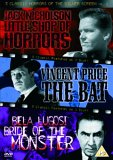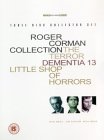![The Little Shop Of Horrors [1960]](/pictures/1042878.jpg) The Little Shop Of Horrors | DVD | (31/03/2003)
from £4.90
| Saving you £-0.91 (N/A%)
| RRP
The Little Shop Of Horrors | DVD | (31/03/2003)
from £4.90
| Saving you £-0.91 (N/A%)
| RRP The original movie of this classic black comedy/horror about a rather dim-witted young man Seymour (Jonathan Haze) working for $10 a week in Mushnick's flower shop on skid row who develops an intelligent bloodthirsty plant. He names the plant ""Audrey 2"" and as it grows it demands human meat for sustenance and Seymour is forced to kill in order to feed it. Jack Nicholson has a notable cameo part as an undertaker Wilbur Force who is a masochistic dental patient and the film also features the writer Charles Griffith as the hold-up man and the voice of 'Audrey Jr'...
![The Little Shop Of Horrors [1960]](/pictures/1012356.jpg) The Little Shop Of Horrors | DVD | (11/08/2003)
from £7.41
| Saving you £-5.42 (N/A%)
| RRP
The Little Shop Of Horrors | DVD | (11/08/2003)
from £7.41
| Saving you £-5.42 (N/A%)
| RRP Seymour Krelbourne works at a struggling flower shop where he shows the owner Gravis Mushnick a plant hybrid he has been working on. Named Audrey II in honour of Audrey Fulguard the plant proves an instant attraction and business at Mushnick's booms almost overnight. A delighted Mushnick invites Seymour and Audrey out for a meal to celebrate their new found success but Audrey already has a date with her boyfriend and Seymour needs care for the ailing plant. Seymour soon realises
![The Little Shop Of Horrors [1960]](/pictures/1012686.jpg) The Little Shop Of Horrors | DVD | (21/10/2002)
from £10.99
| Saving you £-5.00 (N/A%)
| RRP
The Little Shop Of Horrors | DVD | (21/10/2002)
from £10.99
| Saving you £-5.00 (N/A%)
| RRP Even by Roger Corman's thrifty standards, The Little Shop of Horrors was a masterpiece of micro-budget movie-making. Scripted in a week and shot, according to Corman, in two days and one night, it made use of a pre-existing store-front set that serves as the florist's shop where most of the action takes place. Our hero is shambling loser Seymour Krelboined, sad-sack assistant at Mushnick's skid-row flower shop and who is hopelessly in love with Audrey, his fellow worker. Threatened with the sack by Mushnick, Seymour brings in a strange plant he's been breeding at home, hoping it'll attract the customers. It does, and the store starts to prosper, but Seymour is horrified to discover that the only thing the plant will thrive on is blood, fresh, human blood at that. The sets are pasteboard, the acting is way over the top, and altogether Little Shop is an unabashed high-camp spoof, not to be taken seriously for a second. Even so, Corman notes that this was the movie "that established me as an underground legend". Charles Griffith, the film's screenwriter, plays the voice of the insatiable plant ("FEED ME!"), and billed way down the cast list is a very young Jack Nicholson in a bizarre, giggling cameo as Wilbur Force, a masochistic dental patient demanding ever more pain. The film's cult status got it turned into an off-Broadway hit musical in the 1980s, with a great pastiche doo-wop score by Alan Menken, which was subsequently filmed in 1986. The musical remake is a lot of fun, but it misses the ramshackle charm of the original. On the DVD: Little Shop of Horrors on disc does not even boast a trailer, just some minimal onscreen background info about the production. The clean transfer, 4:3 ratio, and digitally remastered mono sound faithfully recapture Corman's bargain-basement production values. --Philip Kemp
 3 Classic Horrors Of The Silver Screen - Vol. 3 - Little Shop Of Horrors / Bat / Bride Of The Monster | DVD | (06/12/2004)
from £3.53
| Saving you £2.72 (119.82%)
| RRP
3 Classic Horrors Of The Silver Screen - Vol. 3 - Little Shop Of Horrors / Bat / Bride Of The Monster | DVD | (06/12/2004)
from £3.53
| Saving you £2.72 (119.82%)
| RRP Little Shop Of Horrors: The original movie of this classic black comedy/horror about a rather dim-witted young man Seymour (Jonathan Haze) working for $10 a week in Mushnick's flower shop on skid row who develops an intelligent bloodthirsty plant. He names the plant ""Audrey Jr"" and as it grows it demands human meat for sustenance and Seymour is forced to kill in order to feed it. Jack Nicholson has a notable cameo part as an undertaker Wilbur Force who is a masochistic d
![The Little Shop Of Horrors [1960]](/pictures/1012824.jpg) The Little Shop Of Horrors | DVD | (22/04/2002)
from £6.42
| Saving you £3.57 (55.61%)
| RRP
The Little Shop Of Horrors | DVD | (22/04/2002)
from £6.42
| Saving you £3.57 (55.61%)
| RRP The original movie of this classic black comedy/horror about a rather dim-witted young man Seymour (Jonathan Haze) working for $10 a week in Mushnick's flower shop on skid row who develops an intelligent bloodthirsty plant. He names the plant ""Audrey Jr"" and as it grows it demands human meat for sustenance and Seymour is forced to kill in order to feed it. Jack Nicholson has a notable cameo part as an undertaker Wilbur Force who is a masochistic dental patient and the film als
 The Roger Corman Horror Collection | DVD | (03/02/2003)
from £N/A
| Saving you £N/A (N/A%)
| RRP
The Roger Corman Horror Collection | DVD | (03/02/2003)
from £N/A
| Saving you £N/A (N/A%)
| RRP Siren DVD's three-disc Roger Corman Collection contains The Little Shop of Horrors and The Terror, which Corman directed, as well as Dementia 13, which he produced. Though he has a reputation as one of the craftiest businessmen in Hollywood, Corman was too cheapskate in the 1960s to bother copyrighting a bunch of his films and so the same titles have been showing up on video and now DVD from many different distributors. All these films were thrown together in odd circumstances to take advantage of leftover sets, contracted performers or tied-up production funds. Little Shop of Horrors (a disguised remake of A Bucket of Blood) was famously made over a three-day weekend "because it was raining and we couldn't play tennis". The Terror exists because Boris Karloff owed a few days' work after completing The Raven and castle sets were still standing. Dementia 13 was written and directed by a young Francis Coppola in Ireland to take advantage of a European trip made for Corman's The Young Racers. All the films are interesting, in themselves and as footnotes to distinguished filmographies. Little Shop of Horrors has a lasting cult reputation for its blackly comic tale of codependency between a skid-row botanist (Jonathan Haze, relying a bit too much on a Jerry Lewis impersonation) and a blood-drinking, flesh-hungry mutant plant voiced by screenwriter Chuck Griffith ("feed meeee!"), with a creepy cameo from a young Jack Nicholson as a masochist who loves to visit the dentist. The Terror, which has Nicholson as the bewildered lead, is a wilfully incomprehensible Gothic picture made up on the spot by Corman and a handful of other directors (including Coppola and Monte Hellman), climaxing with Karloff's bogus baron and a decaying spectre woman swept away by a flood in the dungeons. Dementia 13, a saga of axe murders and mad sculptors, is brisk grand guignol with a lot of creepy imagery to do with drowned children and family rituals. On the DVD: The Roger Corman Collection limply claims the films are "digitally mastered" (note, not "remastered") as they are simply copies of low-quality video onto disc. Because these titles are public domain no one seems willing to take any care with transfers, and all three films are in terrible state. The Terror, the only colour film, looks especially atrocious (Vistascope cropped to full-frame) but the black-and-white films also suffer all manner of damage. The packaging is classy, but it's a shame more work wasn't done on the films themselves.--Kim Newman

Please wait. Loading...
This site uses cookies.
More details in our privacy policy